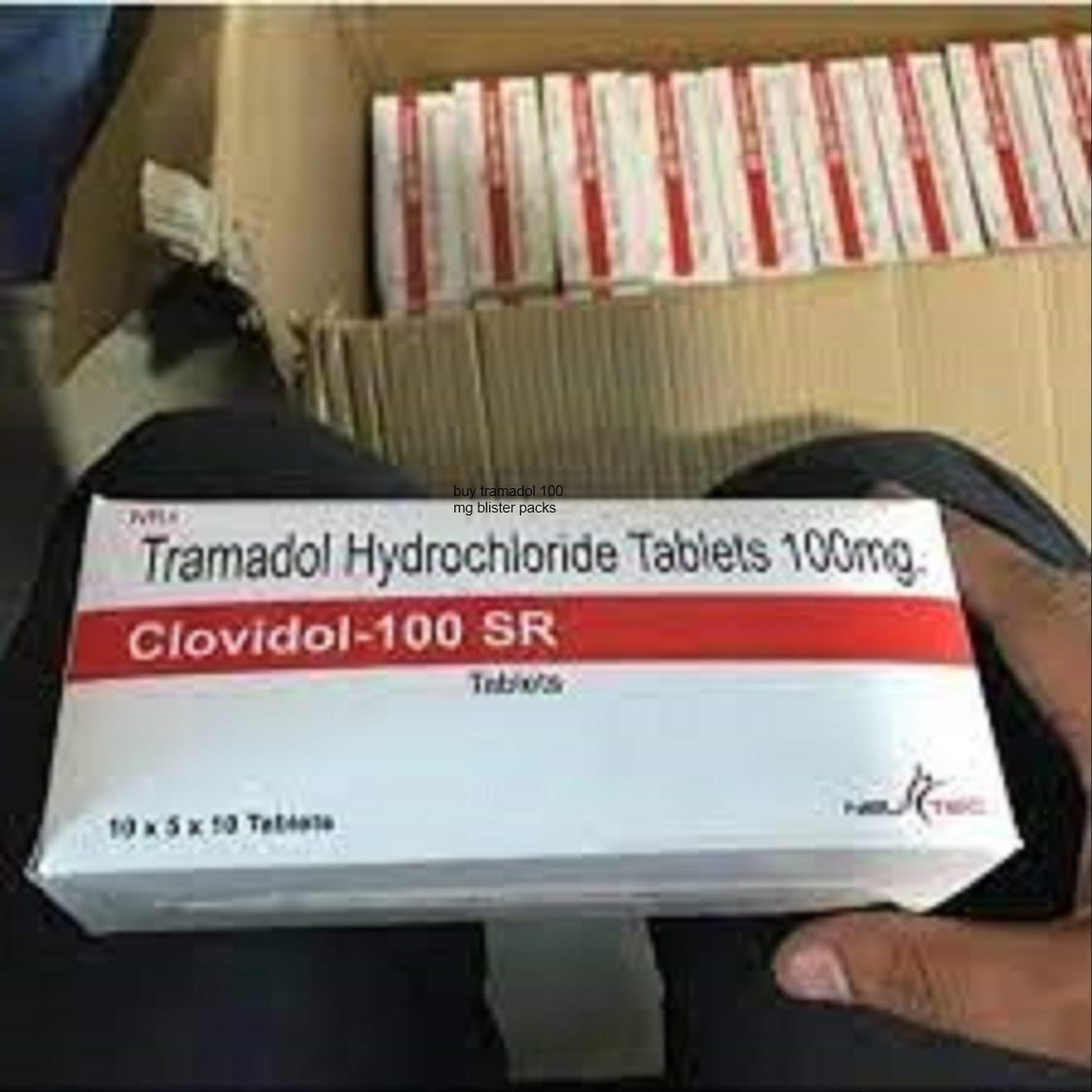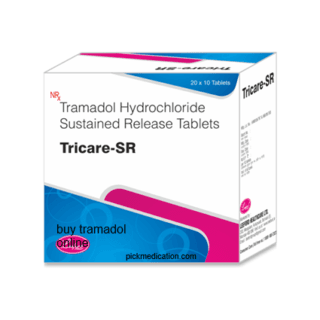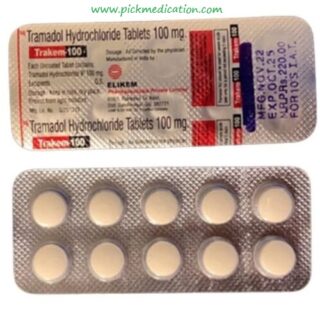Buy Tramadol Blister
Tramadol (Clovidol): A Detailed Overview
Tramadol is a synthetic opioid analgesic (pain reliever) commonly prescribed to manage moderate to moderately severe pain. It is often used for conditions such as post-surgical pain, chronic pain, or injury-related discomfort. In some regions, Tramadol is marketed under the brand name Clovidol, among other names, and may be available in various formulations, including immediate-release and extended-release versions.
While Tramadol is effective in pain relief, it is important to understand that it carries certain risks, including dependence, misuse, and side effects. It is typically prescribed when other non-opioid pain relievers are not effective.
What is Tramadol (Clovidol)?
Tramadol is a centrally acting analgesic, meaning it works by affecting the central nervous system (CNS). It is classified as a Schedule IV controlled substance in many countries due to its potential for abuse and dependence, although it is considered to have a lower risk compared to other opioids. Tramadol’s pain-relieving effects are a result of both its opioid-like effects and its ability to increase the levels of serotonin and norepinephrine in the brain.
Tramadol is available in various strengths, with the most common dosage being 50 mg tablets. The extended-release formulation (often used for chronic pain) can be taken once or twice a day, while immediate-release versions are typically taken multiple times per day as needed.
How Does Tramadol (Clovidol) Work?
Tramadol has a dual mechanism of action:
- Opioid receptor activity: Like other opioids, tramadol binds to mu-opioid receptors in the brain, which are responsible for pain relief. This interaction reduces the perception of pain.
- Inhibition of serotonin and norepinephrine reuptake: Tramadol also inhibits the reuptake of the neurotransmitters serotonin and norepinephrine, which play a role in pain modulation. This mechanism can contribute to its effectiveness, particularly in conditions with neuropathic pain (nerve-related pain).
Due to its action on both opioid receptors and neurotransmitter systems, tramadol can provide significant pain relief, but it does so with a different profile compared to traditional opioids like morphine or oxycodone.
Buy Tramadol Blister (Clovidol)
Tramadol is primarily prescribed to treat moderate pain or chronic pain, but it can also be used for other conditions under medical supervision. Some of the common uses include:
- Post-surgical pain: Tramadol can help manage pain following surgeries such as dental work, orthopedic procedures, or abdominal surgery.
- Injury-related pain: It may be used to treat pain caused by sprains, fractures, or strains.
- Chronic pain: For individuals with chronic pain conditions such as osteoarthritis, back pain, or fibromyalgia, tramadol can help improve quality of life by reducing pain.
- Neuropathic pain: Tramadol’s action on serotonin and norepinephrine makes it particularly effective for nerve pain, which can be challenging to treat with traditional pain relievers.
Dosage and Administration
The recommended dosage of Tramadol (Clovidol) depends on the severity of pain, the formulation, and the individual patient’s needs. The immediate-release formulation is typically taken every 4-6 hours as needed, while the extended-release version is taken once or twice a day.
A common dosing regimen for adults includes:
- Immediate-release: 50 mg every 4 to 6 hours as needed, up to a maximum of 400 mg per day.
- Extended-release: 100 mg to 300 mg per day, depending on the individual’s needs and tolerance. The maximum dose for the extended-release formulation is typically 300 mg per day.
Important: The dose should be adjusted by a healthcare provider based on the patient’s pain level, age, medical conditions, and other medications being used.
Side Effects of Tramadol (Clovidol)
Like other opioid medications, Tramadol (Clovidol) can cause a variety of side effects, ranging from mild to severe. Some common side effects include:
- Drowsiness or dizziness: Tramadol can cause sedation and impair your ability to perform tasks that require alertness, such as driving.
- Nausea and vomiting: These are common when starting treatment or increasing the dosage.
- Constipation: Like other opioids, Tramadol can cause constipation, which may require dietary changes or the use of laxatives.
- Headache: Some individuals may experience headaches while taking Tramadol.
- Sweating: Increased sweating is a potential side effect.
- Dry mouth: Reduced saliva production can cause discomfort and dry mouth.
- Mood changes: Anxiety, agitation, or euphoria can occur, especially with higher doses or long-term use.
Serious side effects can occur, especially in those who misuse the drug or take it in combination with other substances:
- Severe dizziness or fainting
- Severe allergic reactions: Swelling, rash, difficulty breathing, or throat tightness.
- Serotonin syndrome: A potentially life-threatening condition that may occur when Tramadol is taken with other drugs that increase serotonin levels (e.g., antidepressants). Symptoms include agitation, confusion, rapid heart rate, and muscle rigidity.
- Respiratory depression: Especially when combined with other CNS depressants like alcohol or benzodiazepines, Tramadol can slow breathing to dangerous levels, potentially leading to overdose.
- Seizures: Tramadol can lower the seizure threshold, increasing the risk of seizures, especially in those with a history of seizures or who take higher-than-recommended doses.
Precautions and Contraindications
Before taking Tramadol (Clovidol), it is essential to inform your healthcare provider about any underlying health conditions or medications you are taking. Some important considerations include:
- History of substance abuse: Tramadol can be habit-forming, and individuals with a history of substance misuse or addiction should be monitored closely.
- Liver or kidney disease: Because Tramadol is metabolized in the liver and excreted through the kidneys, individuals with liver or kidney issues may need dose adjustments.
- Seizure disorders: Tramadol can increase the risk of seizures, particularly in people with a history of epilepsy or other seizure disorders.
- Breathing problems: Those with respiratory conditions (e.g., asthma, COPD) may be at greater risk for breathing difficulties while taking Tramadol.
- Pregnancy and breastfeeding: Tramadol should only be used during pregnancy if the benefits outweigh the risks, and it is generally not recommended for breastfeeding mothers, as it may pass into breast milk and harm the infant.
Interactions with Other Medications
Tramadol (Clovidol) can interact with a variety of other medications, which may increase the risk of serious side effects. Some of the most dangerous interactions include:
- CNS depressants (e.g., alcohol, benzodiazepines, barbiturates, muscle relaxants): Combining Tramadol with other CNS depressants can lead to excessive sedation, respiratory depression, and even overdose.
- Antidepressants: Tramadol increases serotonin levels, so when taken with other medications that affect serotonin (such as SSRIs, SNRIs, or MAO inhibitors), there is a risk of serotonin syndrome, a life-threatening condition.
- Seizure medications: Since Tramadol lowers the seizure threshold, combining it with other drugs that increase the risk of seizures (e.g., bupropion, antipsychotics) can be dangerous.
- Blood thinners: Tramadol may interact with medications like warfarin, increasing the risk of bleeding.
Signs of Overdose
An overdose of Tramadol is a medical emergency. Symptoms of overdose include:
- Severe drowsiness or sedation
- Slow or difficult breathing
- Loss of consciousness
- Seizures
- Muscle weakness
- Cold, clammy skin
If an overdose is suspected, immediate medical attention is required. Naloxone (Narcan), an opioid antagonist, may be used to reverse respiratory depression in cases of overdose.
Conclusion
Tramadol (Clovidol) is an effective medication for the management of moderate to moderate-severe pain, but like all opioids, it carries significant risks. It should be used with caution, under the supervision of a healthcare provider, and for the shortest duration necessary to control pain. Because of its potential for abuse, dependence, and dangerous interactions, Tramadol should be taken as prescribed, and any changes to dosage or treatment should only be done under the guidance of a doctor.
If you or someone you know is experiencing issues with Tramadol, or if you have concerns about potential misuse, it is important to reach out to a healthcare provider for further evaluation and guidance.
| Quantity | 180 Pills, 360 Pills |
|---|---|
| Delivery Time | 4 to 5 Days |






Reviews
There are no reviews yet.